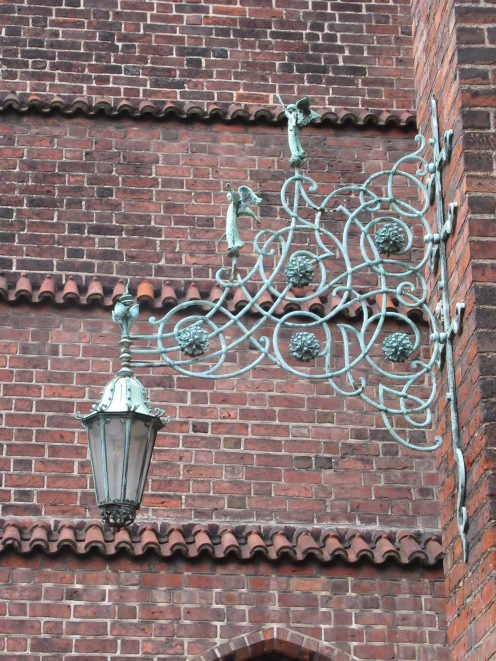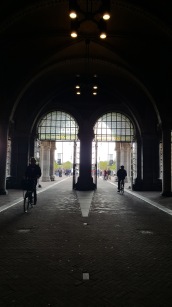The ferry came into Copenhagen on an overcast morning. We lazily made our way to the lobby to disembark and find our way around yet another city. We had our Airbnb booked for the one night we had in the city, and quickly made our way there via train and bus. The shortness of the stay had us energized since we wanted to explore the town in the little time that we had. After a quick check-in with our hosts, and rushed fresh up session, we immediately headed out to find some much needed sustenance.
The concept of food-halls that we had discovered in Cape Town, had, to our joy, continued to follow us along our journey. We found another such warehouse of delicious variety set up along one of the canals which, while being indoors in a dedicated building, was called Copenhagen Street Food. The food inside ran the full gamut from South America to east Asia, with the usual pizza and burger thrown in for good measure. After stuffing our hungry selves, and sheltering from the constant drizzle for a bit, we decided to take a stroll around town. From the food-hall, we walked by a Yoko Ono art installation, where people wrote down their wishes and tied them to trees, and then crossed a bridge into town which turned out to head right into Nyhavn, the historic waterfront district. Nyhavn consists of a long stretch of canal lined on each side with a colorful array of buildings, restaurants and street cafes. The bridge across the canal was decorated with padlocks, from people who left their hopes behind. One end of the bridge had a modern playhouse for the Royal Theatre while the other had a huge square, with some major construction underway. One building portrayed a colossal exhibit called “Soleil Levant”, i.e. Rising Sun, for World Refugee Day; with over 3,500 used life jackets crammed into the building windows, the exhibit sought to bring about awareness of the number of migrants attempting to cross the Mediterranean.
Being in Hans Christian Andersen’s hometown, we decided to give the Little Mermaid a visit – even though I’ve never actually seen/read it, and one of Shweta’s missions is to ensure I get up to speed with all the necessary classic child literature and pop-culture. Along the way we stumbled upon Frederik’s Church, a magnificent church built in sandstone with a massive oxidized copper hued dome, entirely accentuated by gold. The entrance consisted of three imposing doors that opened into a large cylindrical interior and the roof was decorated with murals and paintings in royal blue and gold. Continuing on our stroll, we reached the Kastellet, the 17th century expansive pentagram-shaped fortress, which is used as a military installation to this day. We walked along the star-shaped periphery of the fortress to make our way slowly to the seaward side of the citadel. The walkways have been converted into manicured gardens with lush green grass and a variety of blooming bushes along the pathways. On the other side of the fort, crossing a bridge brought us to the statue of Den Lille Havfrue – The Little Mermaid. The statue is, as the name suggests, of a little mermaid. Cast in bronze, with a silhouette of her feet showing from within her tail, she sits on a rock, itself balancing on other rocks,and looks calmly but longingly towards the ocean. Not too far away is another sculpture, this one a lot larger and much more fierce. The Gefion fountain is a huge sculpture dedicated to the eponymous Norse goddess. She is portrayed on a chariot, controlling her raging bulls by wielding her whip but she too, given her circumstances, has a strangely calm expression on her face. A third sculpture, also in the vicinity, is of a human, made entirely of worn out car, and other machine, parts, also calmly contemplating something – perhaps a way to put the pieces back together.
The next morning, we had a delicious brunch at a Kristin’s Konditori of Danish open-faced sandwiches, and headed out to Freetown Christiania. These old military barracks are now, in an ironic twist of history, a self-proclaimed anarchist district with a pseudo-autonomous government. I have taken the liberty to include the “pseudo” prefix because the security and regulatory systems of the Danish government, still technically hold jurisdiction over this borough of Copenhagen. That being said, this part of town is unlike the rest. The barracks have been converted into everything from art galleries, to short-stay accommodations and concert halls. Pusher street is both the main thoroughfare and primary trading district, the merchants being it’s namesake. Even here, the community regulations ban the sale of what are considered “hard” drugs, and these and others are all banned by the Danish government leading to several conflicts over the years. We walked through the lanes and squares, past a makeshift skatepark and typical hippie merchandise consisting mostly of appropriated Hindu iconography. The public spaces were covered in natural gardens used to produce food. Other “cash” crops such as Marijuana made an unexpected appearance. Elsewhere in the world, even Marijuana plants are banned depending on the socioeconomic interests of the growers. We continued our stroll through this wild and unkempt neighborhood, which was a surprising dose of welcome disorder in an otherwise orderly and manicured Europe. Unfortunately, photography is contraband here, so the only shots we had are a few that we took before realizing the ban.
A short ride on the canal-bus had us back in Nyhavn, and we spent the rest of the day strolling through the more commercial part of town, Indre By. The shopping area here had the typical brands set up in atypical buildings making for an interesting walk around town. We had a very early dinner that evening since we had an overnight bus out of town. We picked up our bags and headed to the bus station, which, we had to find through a maze of construction barricades through the unrelenting drizzle. We dropped our bags and piled into the bus. The run through Copenhagen over the last two days had us completely exhausted and it wasn’t long before we fell asleep.
Amsterdam – land of debauchery – welcomed us the following morning with a soggy embrace. The rain had not let up a bit through our overnight trip here via Hamburg. The bus shovelled us off at Sloterdijk station just outside of town and we took a tram and then a bus followed by a mad dash through the downpour to make it to our small cosy camper, also booked on Airbnb, on the northern bank of river Ij. Since we were a little early for our check-in time, we did a well-timed and much needed load of laundry and waited out the rain. In the afternoon, the weather was a bit drier so we ventured out into town and spent the evening getting to know the city better.
The next couple of days were spent walking along the streets of Amsterdam, taking in the sights of the iconic canals that are the identity of the city, the revelers that come here for the red booths and cafes, and the architecture that is truly unique. The city was gloomy above with it’s grey ceiling that only allowed a few rays throughout the day, but the mood underneath the dome was anything but. Crowds thronged the main thoroughfares everywhere we went, stimulants and depressants blending at the various cafes. This was different than Pusher street in Christiania, and antithetical to the prudish American conversation and politics regarding the matter. Legalization here gave an air of the mundane to the whole affair, there were no sinister sounding whispers on the corners of dark-with-a-reddish-hue alleyways. There was no need for that. The red-light district, with its own set of intoxicants, lent a similar experience albeit a little more exposed (pun not entirely intended, but welcome). While the cafe’s offer a certain level of privacy, the red-light district is out in the open. Window shopping takes on a whole new meaning in this context. We kept our cameras away, for the most part. The gamut of people that can be kept under observation here runs from the uncomfortable family man, pushing his stroller while avoiding eye-contact with anyone except the missus, to the ogling creep who is but a hair’s width away from getting drool on the windows. There are giggling teenagers, and the bachelor parties somehow still manage to stick out in this raucous crowd. There are also judgy-couples strolling the streets; this was people-watching of a different kind.
While in Amsterdam, we had a chance to visit the Rijksmuseum. Unfortunately we had completed misjudged the collection in this behemoth of a building, and so only managed a small fraction of what it had to offer. One of the highlights at the museum was an exhibit showcasing rosary nuts, extremely intricate carvings done in wood assembled into golf-ball sized nuts to be strung onto a rosary. The other place we visited was Anne Frank’s house, now converted into a museum. As you walk up and down the various rooms of the house, you are taken on a journey down Anne’s memory lane. Learning about the various ordeals a child had to go through for being born “wrong” was goosebump inducing, a sad reality even today.
On our last day in Amsterdam we took a cruise on the canals. The typical flat-roofed boats with the rows of seats and glass ceiling moved lazily along the water routes as the guide shouted out interesting things about the buildings around us. As unique as the buildings here are, it is also commendable how well they are maintained. The crooked lines, tilts and bends in the buildings betray the mobile sands underneath as well as the age of the wooden piles holding them up. All the gables have a winch and hook system that is used to furnish these homes. The homes are narrow (one measuring merely a meter wide), but very deep. The boat weaved in and out of canals, going under the small bridges and through old locks out into the Ij, and back around to complete its tour of the city.
With that, our current, rainy, European stay had come to an end. We had a detour back to Africa, to Morocco, which meant catching a flight from Eindhoven. A quick train ride over had us in town to spend the night for the early morning flight out to Fes.
































































